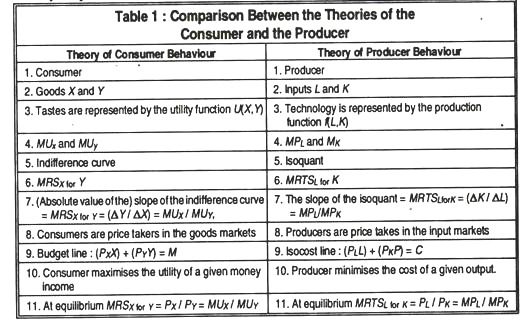In this article we will discuss about the difference between theory of production and the theory of consumption.
In the theory of production, we use certain tools of consumption theory such as indifference curves and budget lines.
The main points of comparison between consumption theory and production theory are the following:
1. The key concept in the theory of consumption is the utility function. Similarly, the key concept in the theory of production is the production function. The utility function is a nice way of summarising a consumer’s taste and preference. It is a function stating that an individual’s utility is dependent upon the goods he consumes and their amounts.
ADVERTISEMENTS:
Similarly, the production function shows the relationship between the output of a good and the inputs (factors of production) required to produce the good. While the consumer buys different goods for satisfying his needs and wants, the producer makes use of various factors of production to produce a saleable good which will be sold at a profit.
2. The objective of the consumer is utility-maximisation. Similarly, the objective of the producer is maximisation of profit. Profit can be maximised by the minimising the cost of production.
While the consumer maximises his utility by choosing an optimum combination of various goods, the producer minimises cost by choosing an optimum combination of variable factors. A related point may also be noted here. While the volume of the output of a firm can be measured, utility enjoyed by a consumer cannot be measured.
3. While the consumer’s indifference curves show different levels of satisfaction or utility, the producers isoquants show different levels of output. While the slope of the consumption indifference curve is the desired rate of commodity substitution (or, the marginal rate of substitution), the slope of the producer’s isoquant is the marginal rate of technical substitution or the desired rate of factor substitution.
ADVERTISEMENTS:
4. A consumer reaches equilibrium when the slope of his budget line (which is the ratio of the two prices) is equal to the slope of the indifference curve (which is the ratio of the marginal utilities of the two commodities).
In other words, consumer’s satisfaction is maximum when the price ratio is equal to the substitution ratio. Similarly, the producer reaches equilibrium in the factor market when his marginal rate of technical substitution between two factors, say, capital and labour is equal to the ratio of their prices.
5. Like the consumer’s budget line or consumption possibility line the producer has also a budget line. The producer’s budget line is called the isocost line or the line of equal cost.
6. In the commodity market, consumers are price-takers. Similarly, in the factors market producers act as price-takers.
ADVERTISEMENTS:
7. While consumers maximise utility with a given amount of money, producers minimise the cost of producing a given volume of output.
8. A consumer responds to a fall in the market price of one of the purchasable goods by altering his purchase of all the goods. The consumer’s reaction is divided into two parts, viz., the substitution effect and the income effect.
Similarly, a producer’s reaction to a change in factor price is indicated by input substitution effect. But, in the long run, when the producer is able to increase his scale of production by changing the usage of all the factors proportionately, we find output expansion effect or scale effect. This is comparable to the income effect which we study in the theory of consumer demand.
The main points of comparison between consumption theory and the theory of production are summed up in the following table:
